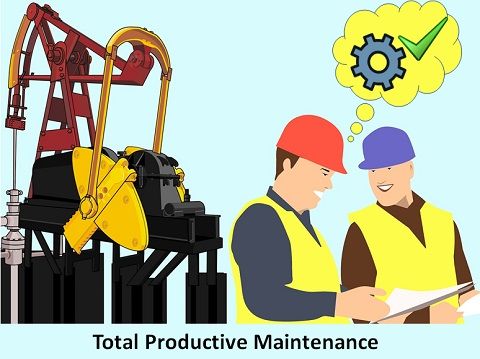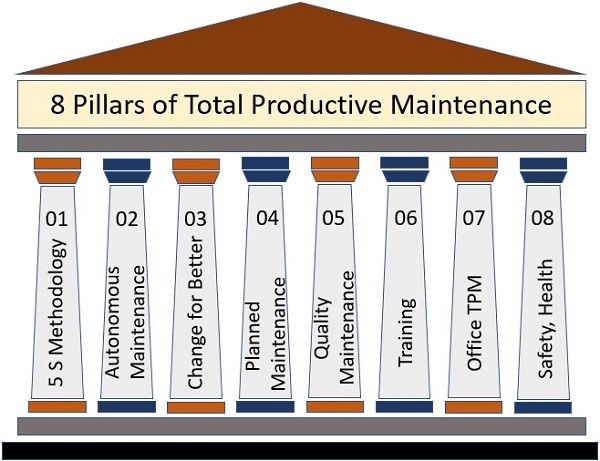Definition: Total Productive Maintenance (TPM) is a lean maintenance concept that maximizes effectiveness by continuous maintenance and improvements in the equipment. It is a combined effort made by the entire organization.
TPM develop a maintenance-free framework by identifying the losses and eliminating them. It will lead to a considerable decrement in the maintenance cost.

Here, every person working in the organization shares the responsibility for product maintenance. Therefore, we can refer it to as ‘Autonomous Maintenance’ or ‘Self-initiated Maintenance‘.
One can beat the global level competition with Proactive and Productive maintenance. Besides, TPM is an operational practice under Quality Management.
Organizations can increase the equipment’s life span by conducting an in-depth Analysis, Inspection and Prevention. They focus on achieving:
- No Breakdowns
- No Accidents
- Zero Small Stops/Slow Running
- Zero Defects
It strives to increase Production, Morale and Job Satisfaction with high-level preventive activities. Also, managers keep the optimal stock of spare parts required in the near future.
Following are the 6 losses that one can prevent by applying TPM:
- Breakdowns
- Setups and Adjustments
- Idling
- Sudden Short-term Shortages
- Defects and Rework
- Start-up Losses
The measure to examine the performance of the maintenance system in Overall Equipment Efficiency (O.E.E). We have discussed it in length further in this post.
Content: Total Productive Maintenance
- Background
- Objectives
- 8 Pillars
- Benefits
- Techniques
- Overall Equipment Efficiency (O.E.E.)
- Conclusion
Background
It was first introduced in Japan in the year 1950 by Seiichi Nakajima. The Japan Institute of Plant Maintenance (JIPM) has split the key phrase into three parts.
Total signifies that the organization must involve all the employees in the maintenance process at all levels.
Secondly, Productive signifies optimum utilization of available resources resulting in perfect production.
Lastly, Maintenance focuses on keeping the plant and equipment always in good condition.
JIPM has also developed eight pillars to achieve Zero-breakdowns, Accidents and Defective Products.
Objectives/Goals
TPM aims to improve organizational efficiency by dedicated preventive maintenance. To achieve this goal, maintenance managers make and fulfil many small objectives like:
- Avoid Wastages: Production of non-defected products, thereby reducing wastage.
- Quality Products: Carry out production without reducing the product’s quality.
- Lower Maintenance Cost: It strives to reduce maintenance costs and deliver products at reasonable prices.
- Increased Production: The production rate increases through total preventive maintenance. As there are fewer breakages and less idle time of machines. Therefore, delivering products at the earliest possible time.
- Fewer Equipment Breakdowns: The machines are kept in good condition, resulting in reduced breakage to a large extent.
- Reduction in Casualties: The equipment is timely inspected and repaired under TPM. It leads to a reduction in the number of casualties.
8 Pillars of Total Productive Maintenance
The 8 pillars of TPM are the components that will enhance the organization’s success. These are the proactive techniques for improving equipment effectiveness.
In addition, each pillar aims at eliminating all kinds of losses mentioned above. These 8 pillars are discussed in detail below:

Pillar 1: 5 S Methodology
This methodology enlightens organizations to remain tidy and organized. Consequently, providing ease in identifying issues and initiation towards improvement.
- Seri (Sort): It suggests that the items must be sorted and placed as per their usage. The materials that are used daily can be kept near the assembly line. On the contrary to it, the items used less frequently may be placed in the warehouses.
- Seiton (Systematise): Managers must ensure each item has a designated space. Also, they must mark, locate and organize these items in a systematic way.
- Seiso (Sweep): As per Seiso, the workplace must be clean and tidy. And it must not be a one-time process but practised at regular intervals.
- Seiketsu (Standardise): Organizations must set standards for all the processes and activities. And they must carry out production as per these standards consistently.
- Shitsuke (Self-Discipline): The workers must perform all four functions religiously and constantly.
Pillar 2: Jishu Hozen (Autonomous Maintenance)
This pillar suggests that the equipment’s operator must look after its maintenance. And the specially appointed maintenance personnel must take care of the critical issues.
Autonomous maintenance helps in routine inspection resulting in the production of defect-free products.
Pillar 3: Kaizen (Change for Better)
The word Kaizen means continuous improvement. By applying this, the organizations can achieve the target of zero losses.
Here zero losses may cover the following:
- Minor stoppages
- Product Damages
- Downtimes, etc
Pillar 4: Planned Maintenance
The manufacturing units pre-plan the maintenance and keep the equipment in its optimum state. It will lead to the production of quality goods that can satisfy customers in the best manner.
Pillar 5: Quality Maintenance
It aims to identify and eliminate the root cause of any defects. Therefore, producing and delivering quality products to the end-user.
Pillar 6: Training
It involves imparting required skills and knowledge to the equipment operators. So, creating a multi-skilled workforce that can handle and resolve the issues, if any.
Pillar 7: Office TPM
This pillar of TPM aims to investigate and cut losses on the administrative front. Some of these losses are as follows:
- Communication Loss
- Processing Loss
- Customer Complaints
- Office Equipment Breakdown
Pillar 8: Safety, Health and Environment
The organizations must work towards achieving Zero Accidents, Health Damage and Fires. Therefore, creating a safe and healthy workplace to work in.
Benefits of TPM
Following are the benefits of applying Total Productive Maintenance (TPM):
- Equipment Availability
- Costs Reduction
- Development of Employees
- Motivated Bunch of Employees
- Better Quality Control
- Decreased Mishaps
- Ensure Pollution Control
- Better Care of Equipment
Techniques Under Total Productive Maintenance
Total Productive Maintenance uses four equipment techniques as follows:
- Preventive Maintenance: This includes making inspections at regular intervals to avoid breakdowns.
- Corrective Maintenance: In this, the equipment’s modifications and improvements are made. It is done with the view to improving reliability and easier maintenance.
- Maintenance Prevention: It involves the installation of such machines that are maintenance-free.
- Breakdown Maintenance: It is required when there are any breakages that need replacement.
Overall Equipment Efficiency (O.E.E.)
It is the performance indicator of the TPM that measures the equipment’s effectiveness. The implementation of TPM increases the overall efficiency of the equipment. It is also one of the KPIs in lean manufacturing.
Overall, Equipment Efficiency is the product of three components, i.e. Uptime, Cycle Time and Quality.

Note: Uptime is the period in which the equipment is actually available out of the total time available.
Conclusion
Total Productive Maintenance is a systematic organization-wide effort to eliminate breakdowns. It includes equipment improvement through continuous maintenance.
It is a blessing for the manufacturing units, as they can save costs and deliver quality products. Hence, with Total Productive Maintenance, organizations can become market leaders and enjoy profitability.
Leave a Reply